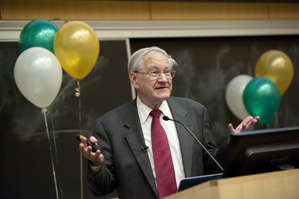The making of a chemist


Richard Ernst won the Nobel Prize in chemistry in 1991 for his work on Nuclear Magnetic Resonance, or NMR, spectroscopy. Photo by Brooks Canaday.
By the time he was 3 years old, Richard Ernst had not yet learned to speak his native language. His only way of communicating was through the translation of his sister, Wreni, who was a year younger and the only person in the world who understood Ernst’s made-up language.
But Ernst—who would eventually go on to earn the Nobel Prize in chemistry—turned out just fine.
As he said in a lecture hosted last week by the Northeastern College of Science and organized by the New England NMR Community, we’re all researchers when we’re children. “We explore the world with our analytical tongues,” he said.
In 1945, Ernst was 12 years old, speaking fluently, and exploring the hidden treasures of his parents’ Victorian home. The “chemical ghosts” of the house, as he put it, urged him to crawl through a tiny door in the attic that he’d never entered before and into a box containing the “remains of an uncle”—no, not his ashes (as I originally thought) but chemicals and experimental equipment.
He set up a lab in the basement and commenced a lifetime of chemical experimentation and analysis. He read all the books on the subject in his parents’ library, though many of them contained incorrect information (such as one that claimed the chemical formula for water to be HO). “I had to relearn chemistry several times after that,” he chuckled.
When Ernst eventually found himself in the office of his graduate adviser, Hans Gunther, discussing potential topics for his dissertation, the professor said, “NMR.” Ernst had never heard the term. “This will be your future life,” Gunther told him.
And then over the next five minutes, Ernst learned that lurking inside every molecule in our bodies are “nuclear spies.” Each atom has unique magnetic properties, which cause it to wobble around, he said. This motion has a precise frequency that can be detected with Nuclear Magnetic Resonance spectroscopy. The technique promised an accurate picture of different types of atoms in a molecule.
The only problem with it back in 1958—when Ernst was an eager, young graduate student—was that it was incredibly slow and therefore not yet feasible as an analytical tool. Ernst spent the next several years developing strategies to speed up the process. In 1963 he traveled to California to work at the forefront of the field with leaders like Wes Anderson of Varian, a prominent instrumentation company.
Anderson suggested Ernst try using 10 separate spectrometers to simultaneously scan a single molecule, and thus break the work up into tenths. But it would also cost 10 times as much as a single scan, Ernst realized. Instead, he called on his experience as a musician. He knew of a mathematical transform, called the Fourier transform, that can take a waveform of recorded music and provide the musical chord that produced it. He used the same approach to inexpensively and effectively reveal the nuclear spies he’d been chasing since his graduate school days.
The idea was to strike the entire molecule at once, as if pounding all the keys on a piano, to elicit a cacophony of individual frequencies. Using the transform, he could disentangle them from the overall response. The computational power of the day kept the turnaround time to an entire week, but thanks to Moore’s law, that soon became a non-issue. To this day, NMRs and MRIs (which use the same principle) rely on Ernst’s breakthrough to elucidate some of the most important problems in science and medicine.
One night in 1991, Ernst was sleeping on a flight from Moscow to New York. He awoke to the pilot telling him he’d received a phone call. This was long before cell phones, so Ernst laughed him off. “Let me go back to sleep,” he recalled saying. But the pilot persisted, and Ernst soon found himself stuffed in the cockpit wearing a radio headset. They’d patched him through to the Nobel Committee in Stockholm who was telling him he’d won the Nobel Prize in Chemistry. It took a few moments to sink in, but when it did, Ernst said, “Then of course I started to explode. I was in an excited state.”
Clearly his early days as a silent explorer gave way to a brilliant researcher. The fact that magnetic resonance now allows us to “see inside virtually everything in nature, from molecules to human heads,” as he put it, is due in no small part to Ernst’s youthful creativity.





